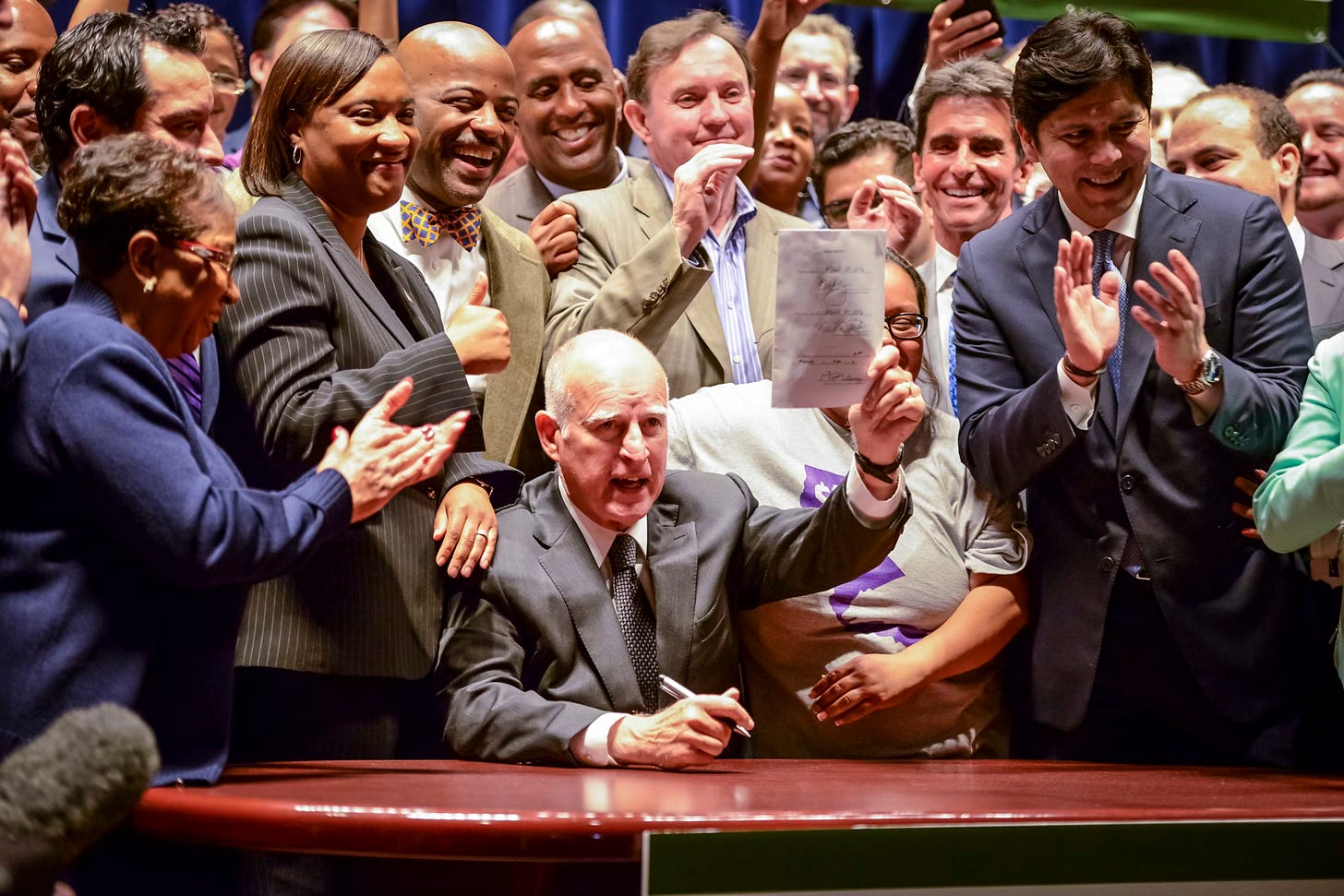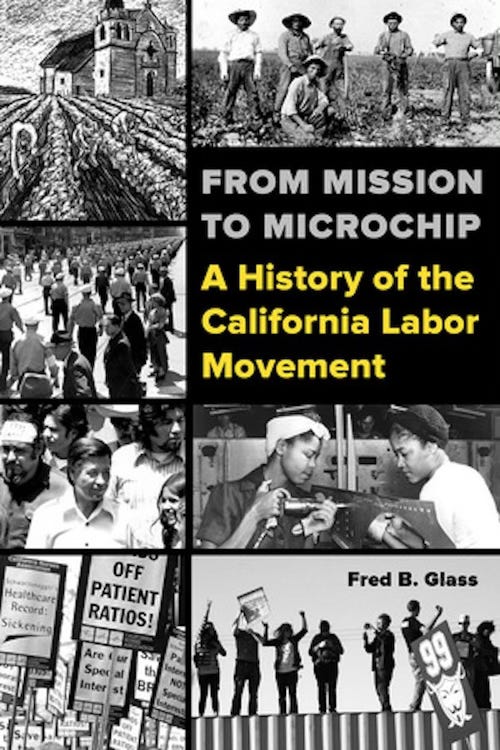The Labor History Behind the Historic Minimum Wage Law
The Labor History Corner--an excerpt from From Mission to Microchip: A History of the California Labor Movement By Fred Glass
A version of this article appeared on the California Labor Federation California Labor History website. You can buy From Mission to Microchip: A History of the California Labor Movement from the University of California Press.

In 2016 California stepped out in front of a movement that was gathering momentum for years. Close to a third of all workers in the state were positively affected by an increase in the minimum wage. All observers agreed: this was an historic moment. But what was the history that culminated here?
As union density declined over the last half century across the country and the globe due to outsourcing, automation, capital mobility and anti-union laws enacted by conservative political regimes, organized labor had to come up with new tactics to protect workers. Especially with national agencies originally created to level the playing field for workers like the Department of Labor, National Labor Relations Board and OSHA struggling with reduced funding and staff, battles for workplace justice devolved to states and cities.
Here in California the agreement reached by Governor Brown and unions to move the state to a fifteen dollar minimum wage over a number of years was built on the shoulders of prior successes in cities, airports, and other local jurisdictions, led by unions, worker centers and central labor bodies, but requiring mass action by workers themselves to demonstrate the seriousness of the need and firmness of their resolve.
Even before the Great Recession, the uneven impact of surging inequality could be easily seen across the landscape of the Golden State. On one hand, an emerging New Gilded Age in the late twentieth and early twenty-first centuries featured skyrocketing salaries and stock options for northern California billionaire titans of the tech industry. Their mansions and privilege recalled the conspicuous consumption of the Big Four railroad moguls and Silver Kings in pre-1906 earthquake San Francisco.
Trailing in their wake, the affluence of a throng of lesser software millionaires transformed formerly affordable neighborhoods in San Francisco and San Jose, jacking up house and apartment costs and pricing out workers and their families.
On the other hand, over the same period the average real income of the poorest fifth of California families fell by more than five percent. “Creative destruction” in the job market created an hourglass economy with growth concentrated in high paying and low wage jobs, and relatively few jobs generated in the middle. The predominance of poorly paying jobs in service and retail sectors resulted in a new subclass of full-time workers who made so little money they qualified for public assistance. More than half the families of fast food workers working forty hours a week received food stamps or qualified for Medi-Cal or the Earned Income Tax Credit.
With the state government blocked by supermajority rules from raising taxes to increase services to the working poor, and the federal government reducing its budgets for local assistance, labor activists and community allies turned to local government for piecemeal action on behalf of low wage workers and their families.
Across the state local coalition efforts led by unions established new floors for the lowest paid workers. In San Francisco, San Jose, Oakland, San Mateo Los Angeles, San Diego, and in smaller municipalities, city councils and boards of supervisors agreed to help workers who, through no fault of their own, had lost the ability to provide for themselves and their families.
The most successful string of local efforts, beginning in the mid-1990s and sustained over time, achieved strong gains for workers in San Francisco, where inequalities were growing faster than in the rest of the state, which in turn were greater than in the nation as a whole.
San Francisco labor traditions, while diminished from their heyday, still provided a firm social justice perspective in the debates over how to address the problems of poverty amidst affluence. Low wage workers and their advocates forged coalitions with an array of community allies, and passed pioneering ordinances by exerting direct pressure on government officials and placing ballot measures before the voters.
As a result of the establishment of several new local labor laws over a dozen years, tens of thousands of San Francisco’s workers benefited from protections against discrimination in employment (Equal Benefits for Domestic Partners, 1996), the ability to unionize hotels and restaurants on city properties without coercive employer resistance (1997), prevailing wages in various service occupations (1999), a citywide minimum wage indexed to inflation (2003), health benefits (2006), paid sick leave (2007), and better labor standards enforcement through a new city department.
Employer representatives, following in the footsteps of their predecessors in predicting calamity if such measures were to be adopted, instead found decreased employee turnover and greater productivity among such diverse occupations as food servers, airport security workers, and home care providers. Dire forecasts of plunging employment due to these supposed “job killer” policies have likewise proven untrue; employment growth in the city is virtually identical with that of surrounding counties.
Similar agreements raised wages and enforced higher workplace standards in the Oakland, San Jose, and Los Angeles airports, with substantial gains for workers and for the businesses where they spend their increased earnings.
More recently unions, led by SEIU and UFCW, have supported a new mass movement of workers in the “Fight for Fifteen” in big box stores and fast food corporations. Thousands of workers willing to perform civil disobedience and risk their jobs and arrest helped move the dial to higher wages and a measure of dignity for people who can’t make ends meet while working for enormously profitable employers.
The law enacted in 2016 relied on the understanding of the governor and legislature of the need for a more realistic minimum wage for people who deserve their share of the California Dream. But that clarity of vision by our elected officials depended on something often overlooked in this age of political unrealism: that most achievements of economic and social justice originate not from above, but from below, and at the center of that movement, pushing up toward something better, we find unions.
Fred Glass is the author of From Mission to Microchip: A History of the California Labor Movement (UC Press, 2016) and a former member of the State Committee of California DSA
Stay tuned for next week’s installment…
Fred Glass is the author of From Mission to Microchip: A History of the California Labor Movement (UC Press, 2016) and a former member of the State Committee of California DSA
Stay tuned for next week’s installment…



